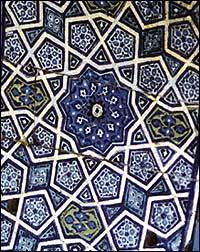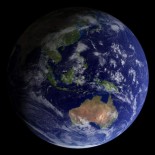Medieval Muslims made stunning math breakthrough
 Sacred Geometry and Holy Numbers, Batman, the Al-Gebra movement really were gifted in Weapons of Maths Instruction. The intricate patterns and architectural wonders of Islamic architecture and art were not just aesthetically beautiful, they were mathematically advanced according to recent research. Five hundred years ahead of their time in fact.
Sacred Geometry and Holy Numbers, Batman, the Al-Gebra movement really were gifted in Weapons of Maths Instruction. The intricate patterns and architectural wonders of Islamic architecture and art were not just aesthetically beautiful, they were mathematically advanced according to recent research. Five hundred years ahead of their time in fact.
The SMH (Feb 26: ‘Patterns of Islamic Genius Crystal Clear Centuries Ago’) features an article in the Science section reporting that Islamic architects in what the West terms the Medieval period were mathematical whizzes.
Harvard University physicist Peter Lu recently discovered quasicrystalline designs on intricate tile and art work, initially after a trip to Uzbekistan. He had been looking for examples in nature of these patterns which were first described in the 1970s by the British mathematician Roger Penrose. Some of the mesmerizing features of these stunning patterns is their complex symmetry and that, akin to a true quasi-crystal, the pattern looks regular but never repeats.
Lu began to study ancient architectural scrolls from Iran, Iraq, Turkey, Afghanistan and other predominantly Muslim countries. As the article reports,
From these training manuals he discovered that by the 1200s the builders had developed a clever toolbox of five differently shaped tiles – a bow tie, a diamond, a pentagon, a hexagon, and a decagon.
“[It] was an important breakthrough in Islamic mathematics and design,” said Mr Lu, whose study is published in the journal Science.
These tools allowed the architects to produce extraordinarily complex designs, such as on the archways in the Sultan’s Lodge in the Green Mosque in Bursa, Turkey, built in 1424.
Some designs were nearly perfect quasicrystalline Penrose patterns, such as the one found in the Darb-i Imam shrine in Isfahan, Iran, created in 1453. [Isfahan is Iran’s third largest city]
“The underlying mathematics were not understood for another five centuries in the West,” Mr Lu said.
Quasicrystalline patterns are made of units that fit together in a predictable way, but do not repeat regularly. They look the same if they are rotated through certain angles, such as 36 degrees or 72 degrees.
The research is conducted by Peter Lu of Harvard University and Paul Steinhardt of Princeton University and appears in the journal Science. (Article in .pdf here)
Peter Lu concludes that “It shows us a culture, that we often don’t credit enough, was far more advanced than we thought before,” he said. Can we let the neocons damage this legacy and these mathematically marvelous architectural splendours?
Reuters article reporting same follows.
Medieval Muslims made stunning math breakthrough
by Will Dunham | Reuters | 22 Feb 2007
WASHINGTON (Reuters) – Magnificently sophisticated geometric patterns in medieval Islamic architecture indicate their designers achieved a mathematical breakthrough 500 years earlier than Western scholars, scientists said on Thursday.
By the 15th century, decorative tile patterns on these masterpieces of Islamic architecture reached such complexity that a small number boasted what seem to be “quasicrystalline” designs, Harvard University’s Peter Lu and Princeton University’s Paul Steinhardt wrote in the journal Science.
Only in the 1970s did British mathematician and cosmologist Roger Penrose become the first to describe these geometric designs in the West. Quasicrystalline patterns comprise a set of interlocking units whose pattern never repeats, even when extended infinitely in all directions, and possess a special form of symmetry.
“Oh, it’s absolutely stunning,” Lu said in an interview. “They made tilings that reflect mathematics that were so sophisticated that we didn’t figure it out until the last 20 or 30 years.”
Lu and Steinhardt in particular cite designs on the Darb-i Imam shrine in Isfahan, Iran, built in 1453.
Islamic tradition has frowned upon pictorial representations in artwork. Mosques and other grand buildings erected by Islamic architects throughout the Middle East, Central Asia and elsewhere often are wrapped in rich, intricate tile designs setting out elaborate geometric patterns.
The walls of many medieval Islamic structures display sumptuous geometric star-and-polygon patterns. The research indicated that by 1200 an important breakthrough had occurred in Islamic mathematics and design, as illustrated by these geometric designs.
“You can go through and see the evolution of increasing geometric sophistication. So they start out with simple patterns, and they get more complex” over time, Lu added.
ISLAMIC ACHIEVEMENTS
While Europe was mired in the Dark Ages, Islamic culture flourished beginning in the 7th century, with achievements over numerous centuries in mathematics, medicine, engineering, ceramics, art, textiles, architecture and other areas.
Lu said the new revelations suggest Islamic culture was even more advanced than previously thought.
While traveling in Uzbekistan, Lu said, he noticed a 16th century Islamic building with decagonal motif tiling, arousing his curiosity as to the existence of quasicrystalline Islamic tilings.
The sophistication of the patterns used in Islamic architecture has intrigued scholars worldwide.
Emil Makovicky of the University of Copenhagen in Denmark in the 1990s noticed the relationship between these designs and a form of quasicrystalline designs. Makovicky was interested in particular in an 1197 tomb in Maragha, Iran.
Joshua Socolar, a Duke university physicist, said it is unclear whether the medieval Islamic artisans fully understood the mathematical properties of the patterns they were making.
“It leads you to wonder whether they kind of got lucky,” Socolar said in an interview. “But the fact remains that the patterns are tantalizingly close to having the structure that Penrose discovered in the mid-70s.”
“And it will be a lot of fun if somebody turns up bigger tilings that sort of make a more convincing case that they understood even more of the geometry than the present examples show,” Socolar said.

LoL Weapons of Math Instruction.
Makes me miss my spirograph from childhood daze. (java applet)
Compared to the Inquisitors, the Moors were a relatively enlightened society.
I don’t expect that we’ll hear much about that though.
What we are seeing these days is the inevitable result of the Balfour-Lawrence policies that disrupted/destroyed entire societies. The artificial “new” societies that they created are unraveling, just like that other European invention once known as Yugoslavia.
Very interesting. Although I believe that there are also octagonal Islamic patterns, which the article does not mention.
Best Regards,
Vincent
Thanks for coming by and for the observation, Vincent. That’s a very interesting sacred geometry site you have there.
Ann